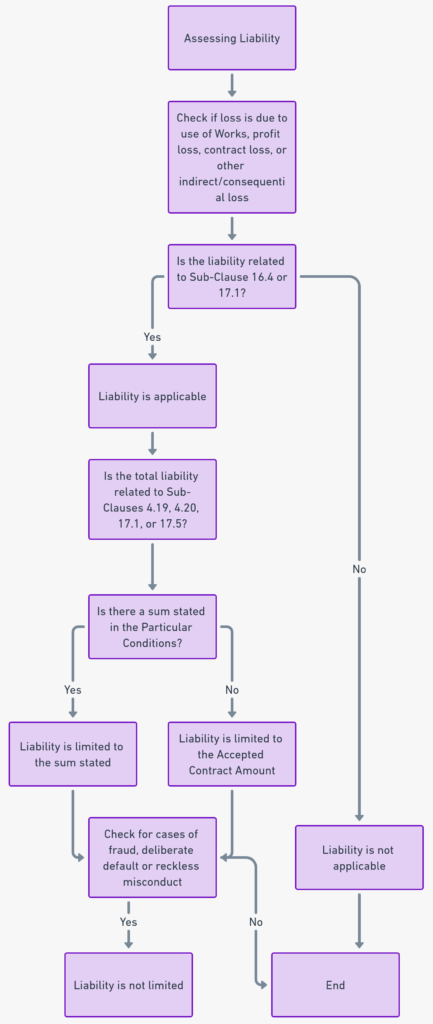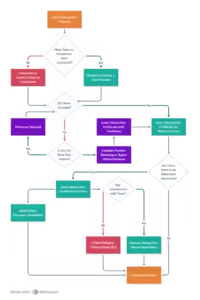Table of Contents
ToggleInterpretations of Clause 17.6 Limitation of Liability:
Purpose and Implications: Clause 17.6 aims to define the bounds of financial liability for both the Employer and the Contractor. This limitation ensures that both parties have a clear understanding of the maximum potential liability they might face, barring specific exceptions. It’s a crucial clause as it protects both parties from potentially crippling financial repercussions.
Primary Aspects:
- Exclusion of Certain Liabilities: The clause primarily excludes both parties from being liable for indirect losses such as loss of profit, loss of use, or any other consequential damages.
- Defined Limit of Liability: The Contractor’s total liability is capped at a predefined amount, either stated in the Particular Conditions or the Accepted Contract Amount.
- Exceptions: There are clear exceptions to these limitations, especially in cases of deliberate misconduct, fraud, or specific clauses like 4.19, 4.20, 17.1, and 17.5.
Expert Opinion: Legal professionals often emphasize the importance of this clause. Given the complexity and scale of construction projects, unbounded liability could result in enormous financial implications. By defining limits, both parties can better manage their risks and financial planning.
Interaction with Other Clauses:
Clause 17.6 has direct linkages with several other clauses:
- Sub-Clause 16.4 [Payment on Termination]: This clause can lead to financial implications, and hence, is excluded from the limitations of Clause 17.6.
- Sub-Clause 17.1 [Indemnities]: Indemnities can lead to substantial payouts, and are, therefore, excluded from these limitations.
- Sub-Clause 4.19 and 4.20: These deal with utilities and employer equipment, which can have significant cost implications.
- Sub-Clause 17.5 [Intellectual and Industrial Property Rights]: Given the potential for large claims relating to intellectual property, this is also excluded from the limitations.
Main Points for Employing Clause 17.6:
- Always verify the sum stated in the Particular Conditions to understand the cap on the Contractor’s liability.
- Be cautious of the exceptions. Claims related to fraud, deliberate default, or misconduct do not have a limit.
- Regularly review potential claims to ensure they don’t unintentionally exceed the limitations set out in this clause.

Flowchart
Detailed Explanation of the Flowchart: “Limitation of Liability Process”
Start: Assessing Liability
- The process begins by assessing the nature and cause of the liability in question.
Check if loss is due to use of Works, profit loss, contract loss, or other indirect/consequential loss
- This step determines if the loss or damage is a result of the use of the Works, loss of profit, loss of a contract, or any other indirect or consequential loss.
Is the liability related to Sub-Clause 16.4 or 17.1?
- If the liability arises from conditions mentioned in Sub-Clause 16.4 (Payment on Termination) or 17.1 (Indemnities), then the liability is applicable. Otherwise, it’s not.
Liability is applicable
- If the liability is related to the mentioned sub-clauses, then it is considered applicable.
Liability is not applicable
- If the liability is not related to the mentioned sub-clauses, then it is not considered applicable.
Is the total liability related to Sub-Clauses 4.19, 4.20, 17.1, or 17.5?
- This step checks if the total liability is related to any of the specific sub-clauses mentioned.
Is there a sum stated in the Particular Conditions?
- If there’s a specific sum stated in the Particular Conditions, the liability is limited to that sum. If not, it defaults to the Accepted Contract Amount.
Liability is limited to the sum stated
- If a sum is mentioned in the Particular Conditions, the liability is capped at that amount.
Liability is limited to the Accepted Contract Amount
- If no specific sum is mentioned in the Particular Conditions, the liability is limited to the Accepted Contract Amount.
Check for cases of fraud, deliberate default or reckless misconduct
- This step checks if the liability arises due to fraud, deliberate default, or reckless misconduct by the defaulting party.
Liability is not limited
- In cases of fraud, deliberate default, or reckless misconduct, the liability is not limited and is fully applicable.
End
- The process concludes after determining the applicability and extent of the liability.
Case Studies
Background: A construction firm was contracted to build a bridge in New York. The project was highly anticipated due to its potential to alleviate traffic congestion in a busy part of the city. The contract value was $150 million, with a liability cap set at $15 million as per Clause 17.6.
Scenario: Six months post-completion, a design flaw was discovered which didn’t pose immediate danger but required extensive repairs. The city claimed a loss of revenue from tolls, increased traffic management costs, and loss of business in the vicinity, amounting to $25 million.
Application of Clause 17.6: While the construction firm acknowledged the design flaw, they invoked Clause 17.6. Their liability was limited to $15 million, saving them from an additional potential loss of $10 million.
Case Study 2: Stadium Construction in California
Background: A company was hired to construct a sports stadium in California. The contract was worth $500 million with a liability cap of $50 million as per Clause 17.6.
Scenario: After the stadium’s inauguration, the electronic systems malfunctioned during a significant event, leading to reputational damage for the event organizers and claims of indirect losses.
Application of Clause 17.6: The event organizers tried to sue the construction company for $80 million, citing lost profits and reputational damage. However, the construction firm, backed by Clause 17.6, was able to limit its liability to $50 million.
Case Study 3: Condo Development in Florida
Background: A real estate developer in Florida contracted a construction company to build a high-end condo. The contract was for $100 million with a liability cap of $10 million.
Scenario: Once families started moving in, a significant plumbing issue surfaced, leading to water damage in several units. Residents claimed not only the repair costs but also loss of rental income and devaluation of their properties, which totaled $15 million.
Application of Clause 17.6: Though the construction company acknowledged the oversight, they referenced Clause 17.6 in the ensuing legal battle. Their total liability remained limited to $10 million.
Sample Letters
Scenario 1: Invoking Limitation of Liability Post-Project Completion
[Your Company’s Letterhead]
[Date]
[Recipient’s Name]
[Recipient’s Address]
Subject: Invocation of **Clause 17.6 Limitation of Liability** regarding [Project Name]
Dear [Recipient’s Name],
We hope this letter finds you well. We are writing concerning the recent claim you have filed related to the [specific issue] at [Project Name].
While we understand and acknowledge the issues you’ve highlighted, we would like to draw your attention to **Clause 17.6 Limitation of Liability** in our contract, which explicitly states the liability limitations agreed upon by both parties.
Given the stipulations of this clause, our liability for the aforementioned issue is limited to [specified amount in the contract].
We value our partnership and are committed to resolving this matter in accordance with our contractual agreement. Please review the clause and advise on the way forward.
Kind regards,
[Your Name]
[Your Position]
[Your Contact Information]
Scenario 2: Acknowledgment of Issue and Citing Limitation of Liability
[Your Company’s Letterhead]
[Date]
[Recipient’s Name]
[Recipient’s Address]
Subject: Acknowledgment of Issue at [Project Name] and Reference to **Clause 17.6 Limitation of Liability**
Dear [Recipient’s Name],
We have received your communication dated [date] regarding [specific issue] at [Project Name]. We deeply regret any inconvenience this may have caused.
After an internal review, we acknowledge the issue and are committed to ensuring its rectification. However, as per our agreement, we would like to highlight **Clause 17.6 Limitation of Liability**, which limits our financial liability to [specified amount in the contract].
We assure you that, despite this limitation, we will strive to ensure the best possible resolution within the confines of our agreement.
We appreciate your understanding and look forward to your response.
Warm regards,
[Your Name]
[Your Position]
[Your Contact Information]
Scenario 3: Clarification on Liability before Project Commencement
[Your Company’s Letterhead]
[Date]
[Recipient’s Name]
[Recipient’s Address]
Subject: Clarification on **Clause 17.6 Limitation of Liability** for [Project Name]
Dear [Recipient’s Name],
As we approach the commencement of [Project Name], we wanted to touch base and ensure clarity on certain contractual aspects. Specifically, we wanted to emphasize the **Clause 17.6 Limitation of Liability** in our agreement.
This clause specifies that our total liability for any issues, barring any exceptions outlined in the contract, is capped at [specified amount in the contract]. This is a standard clause we include to ensure a clear understanding of our responsibilities.
We are dedicated to the successful completion of [Project Name] and felt it necessary to highlight this clause upfront to ensure a smooth partnership.
Please let us know if you have any queries or need further clarification.
Best regards,
[Your Name]
[Your Position]
[Your Contact Information]
Checklists
1. Checklist for Proficient Execution and Deployment of Clause 17.6
| Task | Completed (✓/✗) | Date Completed | Notes |
|---|---|---|---|
| Review the specific terms of Clause 17.6 | |||
| Determine any exceptions within the contract | |||
| Identify and document all potential liabilities | |||
| Calculate the maximum liability cap | |||
| Communicate the liability limits to all parties | |||
| Document any issues that could exceed the cap | |||
| Regularly review the clause with legal counsel | For clarity and adherence |
2. Checklist to Assist in Applying and Overseeing Clause 17.6
| Task | Completed (✓/✗) | Date Completed | Notes |
|---|---|---|---|
| Ensure all team members understand Clause 17.6 | |||
| Set up periodic reviews of potential liabilities | |||
| Monitor contract performance against the liability cap | |||
| Address any concerns or queries related to the clause | |||
| Update stakeholders on any developments related to cap | |||
| Maintain a log of all events that could trigger the cap | |||
| Ensure all claims are within the contractual limitations |
3. Checklist to Guide and Monitor the Execution of Clause 17.6
| Task | Completed (✓/✗) | Date Completed | Notes |
|---|---|---|---|
| Review the contract for any changes to Clause 17.6 | |||
| Track any claims made against the contract | |||
| Validate the legitimacy of each claim | |||
| Ensure claims do not exceed the liability cap | |||
| Document any attempts to exceed the cap | |||
| Report any potential breaches of the clause | |||
| Conduct a post-project review of the clause’s execution |




